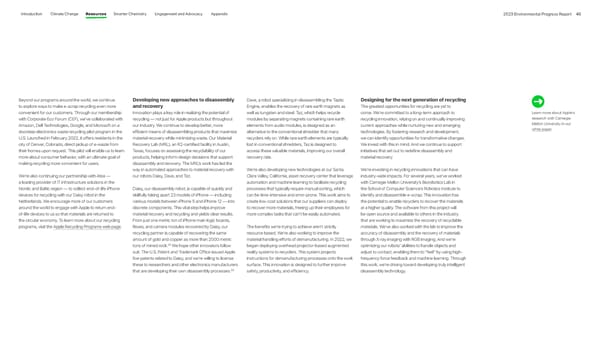Introduction Climate Change Resources Smarter Chemistry Engagement and Advocacy Appendix 2023 Environmental Progress Report 46 Beyond our programs around the world, we continue Developing new approaches to disassembly Dave, a robot specializing in disassembling the Taptic Designing for the next generation of recycling to explore ways to make e-scrap recycling even more and recovery Engine, enables the recovery of rare earth magnets as The greatest opportunities for recycling are yet to convenient for our customers. Through our membership Innovation plays a key role in realizing the potential of well as tungsten and steel. Taz, which helps recycle come. We’re committed to a long-term approach to Learn more about Apple’s with Corporate Eco Forum (CEF), we’ve collaborated with recycling — not just for Apple products but throughout modules by separating magnets containing rare earth recycling innovation, relying on and continually improving research with Carnegie Amazon, Dell Technologies, Google, and Microsoft on a our industry. We continue to develop better, more elements from audio modules, is designed as an current approaches while nurturing new and emerging Mellon University in our doorstep electronics waste recycling pilot program in the efficient means of disassembling products that maximize alternative to the conventional shredder that many technologies. By fostering research and development, white paper . U.S. Launched in February 2022, it offers residents in the material recovery while minimizing waste. Our Material recyclers rely on. While rare earth elements are typically we can identify opportunities for transformative changes. city of Denver, Colorado, direct pickup of e-waste from Recovery Lab (MRL), an R2-certified facility in Austin, lost in conventional shredders, Taz is designed to We invest with this in mind. And we continue to support their homes upon request. This pilot will enable us to learn Texas, focuses on assessing the recyclability of our access these valuable materials, improving our overall initiatives that set out to redefine disassembly and more about consumer behavior, with an ultimate goal of products, helping inform design decisions that support recovery rate. material recovery. making recycling more convenient for users. disassembly and recovery. The MRL’s work has led the way in automated approaches to material recovery with We’re also developing new technologies at our Santa We’re investing in recycling innovations that can have We’re also continuing our partnership with Atea — our robots Daisy, Dave, and Ta z . Clara Valley, California, asset recovery center that leverage industry-wide impacts. For several years, we’ve worked a leading provider of IT infrastructure solutions in the automation and machine learning to facilitate recycling with Carnegie Mellon University’s Biorobotics Lab in Nordic and Baltic region — to collect end-of-life iPhone Daisy, our disassembly robot, is capable of quickly and processes that typically require manual sorting, which the School of Computer Science’s Robotics Institute to devices for recycling with our Daisy robot in the skillfully taking apart 23 m odels of iPhone — including can be time-intensive and error-prone. This work aims to identify and disassemble e-scrap. This innovation has Netherlands. We encourage more of our customers various models between iPhone 5 and iPhone 12 — into create low-cost solutions that our suppliers can deploy the potential to enable recyclers to recover the materials around the world to engage with Apple to return end- discrete components. This vital step helps improve to recover more materials, freeing up their employees for at a higher quality. The software from this project will of-life devices to us so that materials are returned to material recovery and recycling and yields clear results. more complex tasks that can’t be easily automated. be open source and available to others in the industry the circular economy. To learn more about our recycling From just one metric ton of iPhone main logic boards, that are working to maximize the recovery of recyclable programs, visit the Apple Recycling Programs web page . flexes, and camera modules recovered by Daisy, our The benefits we’re trying to achieve aren’t strictly materials. We’ve also worked with the lab to improve the recycling partner is capable of recovering the same resource based. We’re also working to improve the accuracy of disassembly and the recovery of materials amount of gold and copper as more than 2000 m etric material handling efforts of demanufacturing. In 2022, we through X-ray imaging with RGB imaging. And we’re tons of mined rock. 58 We hope other innovators follow began deploying overhead projector-based augmented optimizing our robots’ abilities to handle objects and suit. The U.S. Patent and Trademark Office issued Apple reality systems to recyclers. This system projects adjust to contact, enabling them to “feel” by using high- five patents related to Daisy, and we’re willing to license instructions for demanufacturing processes onto the work frequency force feedback and machine learning. Through these to researchers and other electronics manufacturers surface. This innovation is designed to further improve this work, we’re driving toward developing truly intelligent that are developing their own disassembly processes. 59 safety, productivity, and efficiency. disassembly technology.
 Apple Environmental | Immersive Page 45 Page 47
Apple Environmental | Immersive Page 45 Page 47